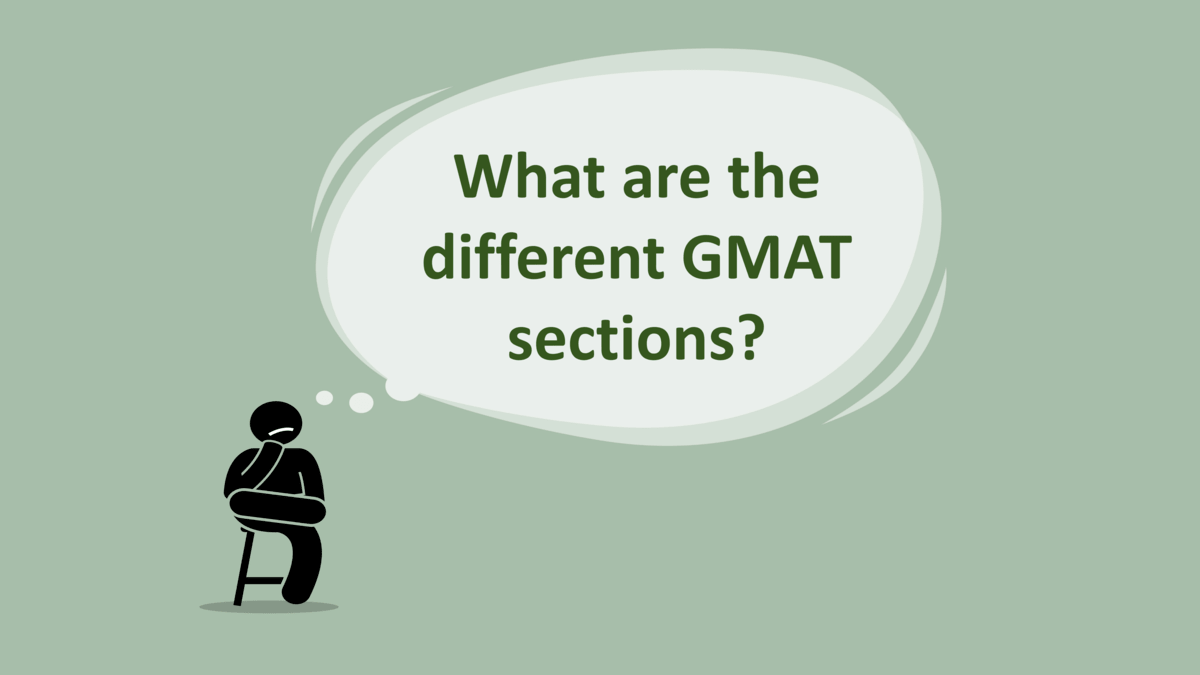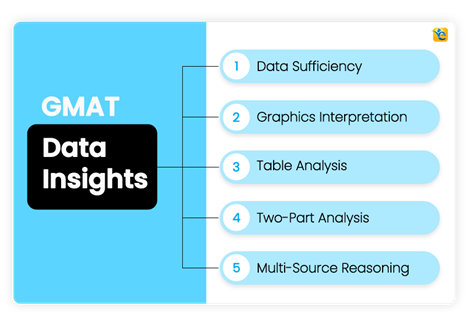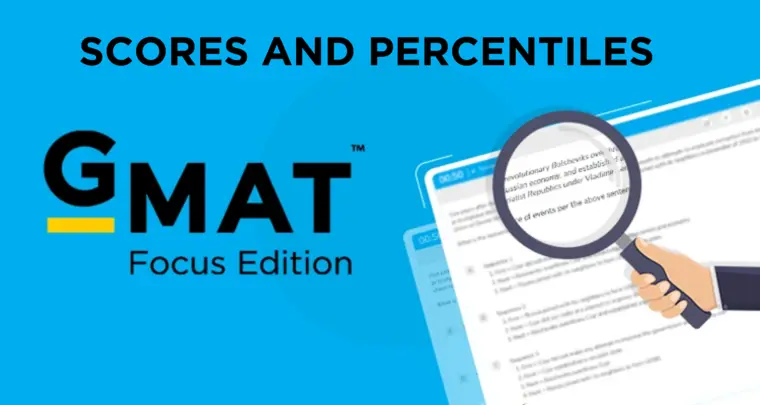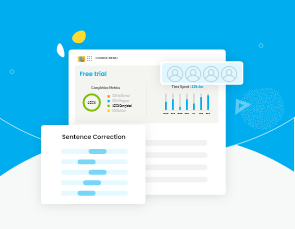The GMAT is a crucial step in your journey to a top business school. Business schools worldwide use your GMAT score to assess your potential for success in an MBA or other management program. A great GMAT score sets you apart, showing admissions committees you have the skills to excel in a fast-paced academic and professional environment.
Recently, the GMAC rolled out an updated GMAT format designed to better align with the skills modern managers need. The new exam is shorter—just 2 hours and 15 minutes—and consists of three sections: Verbal Reasoning, Quantitative Reasoning, and the new Data Insights section. You can take an optional 10-minute break between any two sections, and the exam is scored on a 205 to 805 scale.
In this article, we’ll walk you through everything you need to know about the GMAT; from the exam structure and scoring to preparation tips and recent changes. Whether you’re aiming for your dream MBA or a specialized management degree, this guide will help you understand the GMAT inside out and set you on the path to success.

You can also read about GMAT Syllabus, Study plan , Scoring system , Test dates, GMAT Mocks and GMAT Official Guide.
Access all the GMAT articles here.
- What is the GMAT?
- GMAT Format and Structure
- What is the section order on the GMAT?
- GMAT Scoring System
- Eligibility Criteria for the GMAT
- GMAT Registration Process
- GMAT Exam Fees and Associated Costs
- How to take the GMAT for Free?
- GMAT Test Centers and Online Exam Options
- GMAT Exam Dates and Scheduling
- GMAT Syllabus and Preparation
- Why Choose e-GMAT?
- Sending GMAT Scores to Institutions
- GMAT vs. Other Exams (GRE and CAT)
- Common GMAT Myths and Misconceptions
- What is the Importance of GMAT Score in MBA Application?
- What is the average GMAT score for top business school?
- What is the scope of GMAT in India?
- Why Take the GMAT test?
- What is a good GMAT score?
- How hard is the GMAT?
- How to score high on the test?
- How to overcome a low score?
- How to prepare for GMAT?
- Final Thoughts
- GMAT Exam – FAQs
You can also watch this video, where we answer some important questions related to the GMAT
One of the most effective ways to familiarize yourself with the content and format of the GMAT is by taking a free mock test, which can provide you with a baseline score and help you determine how much preparation you’ll need. Check out e-GMAT’s FREE Sigma-X mock test, which offers personalized feedback to help you identify your strengths and weaknesses and create a tailored preparation plan.
You can also explore our free GMAT trial, which features over 10 hours of AI-driven video lessons and more than 400 practice questions.
What is the GMAT?
The GMAT, or Graduate Management Admission Test, is a standardized exam designed to assess the skills essential for success in business school programs, particularly MBAs. Administered by the Graduate Management Admission Council (GMAC), the exam evaluates a candidate’s ability to reason quantitatively, analyze verbal information, and interpret data—core competencies that are critical in today’s business world.
The GMAT has a long-standing history, first introduced in 1953 to provide a standardized measure for comparing applicants from diverse academic and professional backgrounds. Over the decades, the test has evolved to keep pace with the changing demands of business education and industry. The recent shift to the GMAT Focus Edition, with its shorter duration and streamlined sections, is a response to feedback from schools and test-takers, aiming to make the exam more practical and aligned with real-world problem-solving.
Today, the GMAT is trusted by over 2,400 schools and 7,700 programs worldwide, making it one of the most critical milestones for aspiring business leaders.
GMAT Format and Structure

The Graduate Management Admission Test (GMAT) is a crucial assessment for candidates seeking admission to graduate business programs worldwide. As of 2025, the GMAT has undergone significant changes to streamline its structure and content. This section provides a detailed overview of the GMAT’s format and structure under the latest guidelines.
GMAT Exam Format Overview
The GMAT consists of three main sections:
- Quantitative Reasoning
- Verbal Reasoning
- Data Insights
The total duration of the GMAT exam is 2 hours and 15 minutes, allowing candidates to demonstrate their skills across these three areas. The exam format is designed to be computer-adaptive, meaning that the difficulty of questions adjusts based on the test-taker’s performance.
The GMAT consists of three sections –Data Insights,, Quantitative, and Verbal.
Take a look at the below table to get an idea about the number and types of questions, and the duration of each section.
| Sections | No of Questions | Question types | Section duration |
| Verbal Reasoning | 23 | Reading Comprehension, Critical Reasoning | 45 minutes |
| Quantitative Reasoning | 21 | Problem Solving, (Algebra and Arithmetic) | 45 minutes |
| Data Insights | 20 | Data Sufficiency, Multi-source Reasoning, Table Analysis, Graphics Interpretation, Two-Part Analysis | 45 minutes |
Are you planning to pursue MBA at top business schools? Let us help you conquer the first step of the process i.e., taking the GMAT. Take a free mock test to understand your baseline score and begin your GMAT prep with our free trial. We are the most reviewed online GMAT Prep company with 2800+ reviews on GMATClub.
Data Insights Section
The Data Insights section measures candidates’ ability to analyze and interpret data and apply it to real-world business scenarios. Data Insights leverages Integrated Reasoning and Data Sufficiency question types to measure a newly calibrated digital and data literacy dimension—one of the most relevant and in-demand skills in business today.
- Number of Questions: 20
- Time Allotted: 45 minutes
- Question Types:Multi-Source Reasoning
- Evaluation: This section assesses candidates’ ability to interpret data presented in various formats, emphasizing analytical skills necessary for business decision-making.
The duration to complete the Data Insights section is 45 minutes. GMAT Data Insights syllabus encompasses five types of questions.

| Number of questions | Minutes to complete AWA | Score range |
| 20 Questions | 45 minutes | 60-90 |
You can also check Data Insights Practice Questions.
Quantitative Reasoning Section
It includes 21 multiple-choice questions on Problem-solving (Arithmetic & Algebra) and there will be no geometry question.
| Number of questions | Minutes to complete Quant | Score range |
| 21 total questions (Problem Solving) | 45 minutes | 60 to 90 |
The Quant section includes 21 multiple choice questions that need to be completed in 45 minutes.
- Number of Questions: 21
- Time Allotted: 45 minutes
- Question Types: Problem Solving (focused on algebra and arithmetic)
- Evaluation: This section evaluates mathematical skills and logical reasoning without including geometry or data sufficiency questions.
Here are some tips on scoring Q50+ in this section.
Verbal Reasoning Section
The Verbal section tests your command of standard written English, your ability to read critically and analyze arguments. It consists of 23 multiple choice questions that need to be completed within 45 minutes.
| Number of Questions | Minutes to complete Verbal | Score Range |
| 23 total problems Reading Comprehension Critical Reasoning | 45 minutes | 60 to 90 |
- Number of Questions: 23
- Time Allotted: 45 minutes
- Question Types: Reading Comprehension, Critical Reasoning
- Evaluation: Candidates must demonstrate their ability to read, comprehend, analyze written material, and evaluate arguments.
Are you struggling in scoring high for GMAT verbal? Here are tips on scoring V40+
Explore the detailed breakdown of the GMAT’s three sections—Quantitative Reasoning, Verbal Reasoning, and Data Insights—and understand the exam’s adaptive nature. Learn more in our detailed article on GMAT Exam Format.
How does the Computer Adaptive Test(CAT) work?
GMAT is a computer adaptive test. This means that the testing software adapts to your performance as you progress through the test. Thus, your performance on each question will determine the difficulty level of the next few questions in the exam.
Therefore, the score is calculated on your ability level, i.e., based on the difficulty level of questions that you solve correctly and not just the number of questions that you get right.
Learn in detail about how does the test work as a computer adaptive test and how you can leverage it.
Are you planning to pursue MBA at top business schools? Let us help you conquer the first step of the process i.e., taking the GMAT. Take a free mock test to understand your baseline score and begin your GMAT prep with our free trial. We are the most reviewed online GMAT Prep company with 2800+ reviews on GMATClub.
What is the section order on the GMAT?

You can take the exam in any order with only one optional 10-minute gap between any of the two sections, so you have 18 options in total.

GMAT Scoring System
The GMAT employs a scoring range from 205 to 805 for the overall exam, with each section scored between 60 and 90. The scoring system is designed to comprehensively evaluate a candidate’s abilities across all sections.
Key Features
- No negative marking for incorrect answers.
- The exam can be taken multiple times throughout the year.
- Results are typically available within 5 to 20 days after taking the exam.
The GMAT aims to provide a more streamlined testing experience while still rigorously evaluating essential skills needed for success in graduate business programs. Understanding this format is crucial for effective preparation and achieving a competitive score.
| Sections | Score Range |
| Total Scaled Score | 205 – 805 (In 10-point increments) |
| Verbal Scaled Score | 60- 90 |
| Quantitative Scaled Score | 60- 90 |
| Data Insights | 60- 90 |
Read this article to understand the GMAT score and percentiles in detail.
Eligibility Criteria for the GMAT
Before registering for the GMAT, it’s essential to understand the eligibility requirements:
- Age Requirement: Candidates must be at least 18 years old. Those aged 13 to 17 can take the exam with written consent from a parent or legal guardian.
- Educational Qualifications: The GMAC does not specify any minimum educational qualifications for taking the GMAT. This means you can register for the exam regardless of your academic background. However, individual business schools may have their own academic requirements for admission.
- Nationality: There are no nationality restrictions; candidates from all countries are eligible to take the GMAT.
- Number of Attempts: You can take the GMAT up to five times within a rolling 12-month period and no more than eight times in your lifetime. GMAT Online Exams taken between April 20, 2020 and September 22, 2020 do not count as one of your lifetime limit attempts
Find out the age requirements, educational prerequisites, and policies for retaking the GMAT. Check out our detailed GMAT Eligibility Criteria guide.
GMAT Registration Process
Registering for the GMAT is a straightforward process that you can complete online:
- Create an Account: Visit the official GMAT website and create an account by providing your personal and contact information.
- Schedule Your Exam: After logging in, select your preferred test date and location. The GMAT is available year-round, so choose a date that aligns with your preparation schedule.
- Pay the Exam Fee: The registration fee varies depending on the test delivery method:
- Test Center: USD 275 (would vary based on your location)
- Online Exam: USD 300 (would vary based on your location)
- Payment can be made using credit or debit cards, including VISA, MasterCard, American Express, and Discover.
- Confirmation: Once you’ve scheduled and paid for your exam, you’ll receive a confirmation email with your test details.
Additional Considerations:
- Rescheduling or Cancellation: If you need to reschedule or cancel your exam, fees will apply, and the amount depends on how far in advance you make the change.
- Identification Requirements: On test day, you’ll need to present valid identification, most probably a passport that matches the name you used during registration.
Follow a step-by-step guide to registering for the GMAT exam, including key deadlines and options for rescheduling. Visit How to Register for the GMAT for a complete walkthrough.
Are you planning to pursue MBA at top business schools? Let us help you conquer the first step of the process i.e., taking the GMAT. Take a free mock test to understand your baseline score and begin your GMAT prep with our free trial. We are the most reviewed online GMAT Prep company with 2800+ reviews on GMATClub.
GMAT Exam Fees and Associated Costs
Understanding the financial aspects of the GMAT is crucial for effective planning. Here’s a breakdown of the costs involved:
Registration Fees:
- Test Center Exam: $275
- Online Exam: $300
Additional Costs:
- Rescheduling Fees:
- More than 60 days before the exam: $55
- 15 to 60 days before the exam: $110
- 1 to 14 days before the exam: $165
- Cancellation Fees:
- More than 60 days before the exam: $110 refund ($165 cancellation fee)
- 15 to 60 days before the exam: $80 refund ($195 cancellation fee)
- 1 to 14 days before the exam: $55 refund ($220 cancellation fee)
- Additional Score Reports: $35 per report
Accepted Payment Methods:
- Credit/Debit Cards: Visa, MasterCard, American Express, Discover
- Other Methods: Personal checks, money orders, and cashier’s checks are also accepted.
Please note that fees may vary by location and are subject to change. For the most current information, it’s advisable to check the official GMAT website or authorized test centers.
Get a breakdown of GMAT fees for test centers and online exams, including costs for rescheduling, cancellations, and score reports. Learn more in our GMAT Fees and Costs article.
How to take the GMAT for Free?
GMAC offers you to take the test at a reduced price or waiver off the registration fee. Anyone can apply for a GMAT fee waiver, however, the applicants cannot directly apply. Your business school should request it.
GMAC allows business schools to decide their criteria to define the financial need of their students.
Thus, if you wish to avail fee waiver, you will have to prove your financial shortcoming to your school.
Check out this article to know where you can apply for the Fee Waiver.
GMAT Test Centers and Online Exam Options
When planning to take the GMAT, you have two primary options: at a test center or online. Each has its own set of advantages and considerations.
Test Centers
- Availability: GMAT test centers are located worldwide, offering a controlled environment with standardized testing conditions.
- Pros:
- Stable Environment: Minimized risk of technical issues.
- Immediate Assistance: On-site staff can address any concerns during the exam.
- Cons:
- Scheduling Constraints: Limited by available dates and times.
- Travel Requirements: This may require commuting, which can add stress.
Online Exam
- Availability: Allows you to take the GMAT from the comfort of your home, providing greater flexibility in scheduling.
- Pros:
- Convenience: No need to travel; familiar environment.
- Flexible Scheduling: More test dates and times are available, including weekends and holidays.
- Cons:
- Technical Requirements: Requires a reliable computer and internet connection.
- Potential Distractions: The home environment may have interruptions.
- Limited Retakes: Online GMAT may have restrictions on the number of retakes allowed.
Considerations
- Exam Structure: Both formats have the same structure and content, ensuring consistency in assessment.
- Score Acceptance: Business schools may have a preference for the test center-based GMAT exam. Visit your target school’s admissions page to get precise information.
When choosing between the two, consider your personal comfort, technical readiness, and any external factors that might affect your test-taking experience. Read our GMAT Test Center vs GMAT Online Exam Guide.
Check out this article to know how to start your preparation at home and how much time you need to reach your targeted score.
GMAT Exam Dates and Scheduling
The GMAT offers significant flexibility, allowing candidates to choose a test date that best suits their preparation timeline and business school application deadlines. You can take the GMAT throughout the year, either at a test center or online.
Scheduling Your Exam:
When scheduling your GMAT exam, it’s essential to plan ahead. Test centers may have limited availability during peak application periods, so booking your slot 2-3 months in advance is recommended. For online exams, candidates have more flexibility in terms of dates and times. You can register for the exam and manage your appointment through your GMAT account on the official website.
Rescheduling and Cancellation:
If unforeseen circumstances arise, you can reschedule or cancel your exam. Keep in mind that rescheduling or canceling closer to your test date incurs higher fees.
- Rescheduling more than 60 days in advance: $50
- Rescheduling 15 to 60 days in advance: $100
- Rescheduling 1 to 14 days in advance: $150
Tips for Choosing the Best Exam Date:
- Align with your application timeline: Ensure your GMAT scores will be ready before your target schools’ deadlines.
- Allow for potential retakes: In case you need to retake the exam, schedule your first attempt well in advance of the deadline.
- Peak performance periods: Choose a date when your personal and professional commitments are minimal, allowing you to focus entirely on the exam.
For more detailed guidelines on GMAT exam dates and scheduling, including step-by-step instructions and expert tips, check out this resource.
Are you planning to pursue MBA at top business schools? Let us help you conquer the first step of the process i.e., taking the GMAT. Take a free mock test to understand your baseline score and begin your GMAT prep with our free trial. We are the most reviewed online GMAT Prep company with 2800+ reviews on GMATClub.
GMAT Syllabus and Preparation
The GMAT evaluates critical skills for business and management through three core sections:
- Verbal Reasoning (23 Questions, 45 Minutes):
This section includes multiple-choice questions focusing on:- Reading Comprehension: Analyze written passages and answer related questions.
- Critical Reasoning: Evaluate arguments and draw logical conclusions.
- Quantitative Reasoning (21 Questions, 45 Minutes):
This section tests problem-solving abilities using arithmetic and algebra. Notably, geometry questions have been excluded in the new format. Key areas include:- Problem-Solving: Apply mathematical concepts to solve word problems.
- Data Insights (20 Questions, 45 Minutes):
The newest section evaluates your ability to interpret and analyze data through various question types:- Data Sufficiency
- Two-Part Analysis
- Multi-Source Reasoning
- Graphic Interpretation
- Table Analysis
GMAT Preparation Tips
- Use the GMAT Official Guide for authentic practice questions.
- Enroll in online courses, like e-GMAT, for structured learning and interactive lessons.
- Take timed mock tests like Sigma-X to build exam-day stamina and improve time management.
- Review your mistakes to identify weak areas and refine your strategy.
- Stick to a consistent study schedule, allocating more time to challenging sections.
For detailed preparation strategies and the latest syllabus updates, visit GMAT Syllabus.
Why Choose e-GMAT?
Join thousands of successful test-takers who’ve achieved their dream scores with e-GMAT. Try our free trial today, experience the difference with Sigma-X Mocks, and read our success stories of students who’ve transformed their scores and secured admissions to top business schools.
Sending GMAT Scores to Institutions
The GMAT allows you to send your scores to up to five programs for free. You must send your (up to 5) free score reports within 48 hours of your Official Score being made available on mba.com. You can update these selections later for an additional fee.
Fees for Additional Score Reports:
- If you wish to send your scores to more than five institutions, you’ll need to pay a fee of $35 per report.
Score Cancellation and Reinstatement:
- Score Cancellation: After you receive your official score reports, you can choose to cancel them if they don’t meet your expectations. Canceled scores are not sent to schools.
- Score Reinstatement: If you later decide to reinstate a canceled score, you can do so for a fee of $50, provided the cancellation occurred within the last four years and 11 months.
Tips for Selecting Schools:
- Research programs thoroughly to ensure your scores are sent to schools that align with your career goals.
- Utilize the free score report option to save costs and prioritize your top-choice programs.
For more details on GMAT score reporting, cancellation, or reinstatement, visit the official GMAT website or consult their guidelines.
Retaking the GMAT is a great opportunity to improve your score and strengthen your MBA application. Here’s what you need to know about the policies and strategies for retaking the exam:
Retake Policies:
- Waiting Period: You must wait 16 days before scheduling a retake.
- Maximum Attempts: You can take the GMAT up to five times in a rolling 12-month period and no more than eight times in your lifetime.
- Score Retention: All scores from the last five years remain available for reporting, so you can choose which scores to send to schools.
Strategies for Improving Scores:
- Review Your Previous Exam: Analyze the Enhanced Score Report (ESR) to identify areas for improvement, such as Verbal, Quantitative, or Data Insights.
- Adjust Your Study Plan: Focus on weaker sections and adopt new strategies or resources to address gaps in knowledge.
- Take Practice Tests: Simulate real test conditions to build endurance, improve time management, and get accustomed to the exam format.
- Seek Professional Guidance: Work with a tutor or enroll in online courses to get personalized advice and targeted preparation.
- Stay Positive: Use your previous experience as a learning tool and approach your next attempt with confidence.
For a detailed guide on retaking the GMAT effectively, explore How to Retake the GMAT and discover tailored strategies to maximize your score.
Are you planning to pursue MBA at top business schools? Let us help you conquer the first step of the process i.e., taking the GMAT. Take a free mock test to understand your baseline score and begin your GMAT prep with our free trial. We are the most reviewed online GMAT Prep company with 2800+ reviews on GMATClub.
GMAT vs. Other Exams (GRE and CAT)
Selecting the right entrance exam is a critical step toward your MBA or graduate management education. The GMAT is designed specifically for business school applicants, testing skills such as quantitative reasoning, data interpretation, and verbal analysis. Top business schools around the world widely accept it and is often preferred for MBA programs.
The GRE, on the other hand, has broader applicability and is accepted by both MBA and other graduate programs. It offers more flexibility in question navigation and allows the use of a calculator in the Quantitative section, making it a good choice for candidates considering a range of academic paths.
For those targeting Indian management schools like the IIMs, the CAT is a focused option. It is conducted annually, with a unique percentile-based scoring system. However, it is not internationally recognized, making the GMAT a better choice for global opportunities.
Your target programs, career goals, and testing preferences should guide your decision. For a deeper dive into how these exams differ and which suits your goals best, explore GMAT vs GRE and GMAT vs CAT.
Common GMAT Myths and Misconceptions
When it comes to the GMAT, many myths and misconceptions can create unnecessary stress or mislead candidates. Let’s debunk some of the most common ones and show how e-GMAT can help you succeed:
Myth 1: Retaking the GMAT Hurts Your Chances
- Fact: Business schools typically consider your highest GMAT score, not how many attempts it took. Retaking the test is often seen as a sign of perseverance and determination. With e-GMAT’s personalized study plans and adaptive learning tools, many students have achieved remarkable score improvements on retakes.
Myth 2: The GMAT is Only for Math Experts
- Fact: The Quantitative section tests problem-solving skills using basic arithmetic and algebra—not advanced mathematics. e-GMAT’s Quant course simplifies even the toughest topics with step-by-step strategies and provides practice tailored to your level. Our students have achieved stellar Quant scores, with many surpassing 700 overall.
Myth 3: You Can’t Prepare for the Verbal Section
- Fact: The Verbal section includes Reading Comprehension and Critical Reasoning, both of which are trainable with the right approach. e-GMAT’s Verbal course focuses on mastering logical reasoning and improving reading speed through proven techniques. Plus, you can start your preparation with a free trial to experience our unique methods firsthand.
Myth 4: The GMAT Score is the Sole Determinant for Admission
- Fact: While important, the GMAT is only one part of your application. A high score helps your profile stand out, and e-GMAT’s Sigma-X mocks simulate the real exam, helping you prepare for every aspect of test day.
Myth 5: Only First-Time Scores Matter
- Fact: Schools focus on your best performance, regardless of the number of attempts. e-GMAT students have a track record of significant improvements on retakes, with some achieving 100+ point increases.
What is the Importance of GMAT Score in MBA Application?

Business schools trust and use the GMAT or Graduate Management Admissions Test (full form) score to make admissions decisions. Your score can help you stand out during the admissions process, and it is the most widely used and trusted indicator of academic success in MBA and other graduate business degree programs.
Did you know 9 out of 10 MBA admission decisions are made using a GMAT score?
Schools know that if you take the GMAT, you are serious about earning an MBA, and your score is a proven predictor of your ability to succeed in your chosen program.
Read here to know more about the importance of the test.
Are you planning to pursue MBA at top business schools? Let us help you conquer the first step of the process i.e., taking the GMAT. Take a free mock test to understand your baseline score and begin your GMAT prep with our free trial. We are the most reviewed online GMAT Prep company with 2800+ reviews on GMATClub.
What is the average GMAT score for top business school?
Generally, a good GMAT Classic Edition (GCE) score falls within the range of 700 (87th Percentile) to 740 (97th Percentile) which translates to 645 (87th Percentile)- 695 (97th Percentile) on the GMAT Focus Edition (GFE), while a score of GCE 740/GFE 695 or higher is deemed excellent.
Deciphering GMAT Average Scores : Regional Insights for Business School Admission:
- United States : GCE 713 / GFE 665, Range: GCE 670 / GFE 615 to GCE 737 / GFE 685
- Europe : GCE 679 / GFE 635, Range: GCE 642 / GFE 595 to GCE 714 / GFE 665
- Canada: GCE 520 / GFE 495 to GCE 780 / GFE 755
- Australia : GCE 600 / GFE 545 to GCE 695 / GFE 635
What is the scope of GMAT in India?
At the moment, most Indian Business schools accept GMAT scores of domestic students for their executive MBA Programs. However, the test is becoming more popular in India, and we can expect more b-schools to start accepting GMAT for MBA admissions. One of the Indian b-school that accepts GMAT score is ISB (Indian School of Business).
Except for 4-5 MBA colleges in India, all accept XAT/NMAT/CAT or other tests for admission to their MBA program.
Check out the other business schools in India that accept GMAT score.
Why Take the GMAT test?

Taking the GMAT elevates you from the rest of the pack because:
- It demonstrates your commitment, ability, and motivation to succeed in business schools
- It connects you with the best-fit program through personalized program recommendations
- It increases your earning potential
- It opens a world of opportunities
- Business schools trust this test to make an informed admission decision
- It measures your reasoning and critical thinking skills – the most relevant skills you need to get into top business schools
Learn about what role does GMAT play beyond getting admission in a business school?
There are a lot of answers as to why take this test, here are the top three reasons why you should take it:
- High chance of scholarship
- Admit in the Top business school
- Better Post-MBA job and salary
Read about the above points in detail here.
What is a good GMAT score?
A good score is the one, which will help you get admission from your dream B-school. Thus, the answer to this question depends on which business school you are targeting.
Here is a 5 step process that you can use to identify a good test score:
- Step 1: Self-Assessment
- Step 2: Identify your target business school
- Step 3: Research your target business schools
- Step 4: Refine the list of targeted business schools
- Step 5: Arrive at a good score for you
Check out the above points in detail here.
Good Exam Score for Business Schools
Darden School of Business, Duke Fuqua, NUY Stern, London Business School, Yale SoM, Michigan Ross, UC Berkeley Haas, Dartmouth Tuck, INSEAD, MIT Sloan, Indian School of Business (ISB), Chicago Booth, Northwestern Kellogg, Wharton, Columbia, Stanford GSB, and Harvard.
What is a good score for MBA Scholarships?
A high score can get you an MBA scholarship. However, scholarship committees do not list a minimum score to guarantee a scholarship. But, a high score can only increase your chances of getting one. Read this article to know about the 5 secrets to getting an MBA scholarship.
Check out the success story of students who got MBA Scholarships. All scored above 730 on the test:
- Admit from Dartmouth Tuck and Michigan Ross with Scholarship
- Kellogg Admit with Scholarship
- MBA Scholarship worth $180,000
How hard is the GMAT?
At its core, the GMAT or Graduate Management Admissions Test (full form) is a test of high-order reasoning skills. This test is taken by 200,000+ people every year, and the average score at the top business schools is 665+. And that is not all. Only 6% of the test takers score 665+ or above in the test.
Read this article to know – “Is the GMAT Hard?”
Here are some reasons for what makes this test a tough nut to crack:
- Computer Adaptive Nature
- Content
- Timing Pressure
- Format
- Other Factors
Are you planning to pursue MBA at top business schools? Let us help you conquer the first step of the process i.e., taking the GMAT. Take a free mock test to understand your baseline score and begin your GMAT prep with our free trial. We are the most reviewed online GMAT Prep company with 2800+ reviews on GMATClub.
How to score high on the test?
Here are seven steps to score 645+ on the exam:
- Attend a strategy session and decide your targeted score
- Set up your baseline
- Decide on the verbal and quant score
- Create a sequence of study and allocate hours
- Track your improvement
- Take mock tests
Read here to know the stepwise process to score 700+ on the exam
How to overcome a low score?

The following are some of the things you can focus on to improve your application if you have a low score and no time to retake the test:
- Focus on optional MBA Essay questions
- Take up some supplemental coursework to demonstrate your quantitative ability
- Prepare and perform well for the interview
- Prepare well for Video Essay questions
- Ask for Waivers
- Revisit your school selection to identify programs which have a lower average incoming score
Read here to know what Adcoms think about a low score and is retaking GMAT worth it?
How to prepare for GMAT?
Watch this video to learn about the 5 steps to scoring 645+ on the GMAT:
Here are some articles on GMAT Preparation:
- Preparation Tips for Beginners and Common mistakes to avoid
- 12 expert Preparation Tips
- How to prepare at Home
- GMAT Anxiety – How to tackle it?
- How to study for the exam in 3 months
- How to focus on Preparation and overcome procrastination
Quant Preparation Articles
- Six Process Skills to master the Quant section
- 6 Quant questions to improve your score
- Why is infer a critical process skill to master Quant?
- How to translate process skill to help you score Q50-51
- Tips for scoring Q50+
Verbal Preparation Articles
Are you planning to pursue MBA at top business schools? Let us help you conquer the first step of the process i.e., taking the GMAT. Take a free mock test to understand your baseline score and begin your GMAT prep with our free trial. We are the most reviewed online GMAT Prep company with 2800+ reviews on GMATClub.
Final Thoughts
The GMAT serves as a critical step in your journey to business school and a successful career. By understanding its structure, scoring system, and preparation strategies, you can approach the exam with confidence and clarity. Whether you’re navigating common myths, comparing the GMAT to other entrance exams, or retaking it to improve your score, the right resources and strategies make all the difference.
Take advantage of expert preparation tools like e-GMAT’s GMAT Prep Course, Sigma-X Mocks, and personalized courses to maximize your score. Start your journey today, and let the GMAT be the stepping stone to your dream program.
For more in-depth guidance, explore the detailed articles linked throughout this guide and arm yourself with the knowledge to excel.
GMAT Exam – FAQs
Now that you are aware of what is GMAT and its full form, here are a few more questions related to the GMAT exam:
The GMAT Exam is designed to assess analytical, quantitative, verbal, and writing skills and is an important component of the MBA applications of top business schools across the world.
The registration fee for the test is $275 in India. But, the cost will be more than just the registration fee of $275. There are many other costs that are associated. Read this article to know how much does the GMAT cost?
GMAT stands for the Graduate Management Admissions Test.
GRE is required for getting into graduate school, whereas the GMAT is the standardized test for getting admissions to a business school. Both tests are valid for five years. One of the significant differences between the GMAT and the GRE section is that GRE doesn’t have an IR section.
Learn more differences between GMAT and GRE.
The CAT and GMAT tests are both entrance tests accepted by top business schools in India. But, the primary difference between them is that while GMAT is a global exam accepted by over 2000+ business schools and 7000 graduate management programs, CAT is a national-level entrance exam.
Read this article to know the difference in the structure and format of the CAT and GMAT exam.
The total time to take the test is 2 hours 15 minutes, with a 10 minute optional break during the exam.
When it comes to overall difficulty level, both GMAT and GRE are similar. However, the GRE verbal section tests challenging vocabulary than GMAT. Similarly, GMAT Quant is considered to be harder than GRE as it tests your problem-solving skills.
Yes, you can retake the GMAT test. Here is a five-step strategy for retaking the GMAT:
1. Identify gaps per your target GMAT score
2. Analyze your previous attempts
3. Estimate the time you need to prepare
4. Create a study plan
5. Track your improvement
Read in detail the points mentioned above.
Yes. you can reschedule or even cancel your GMAT appointment but with a fee. Check out the reschedule and cancellation fee here.












